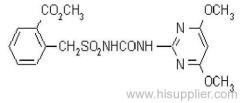Common name: bensulfuron-methyl
Chemical Abstracts name: methyl 2-[[[[[(4,6-dimethoxypyrimidin-2-yl)-amino]carbonyl]amino]sulfonyl]methyl]benzoate
CAS RN: [83055-99-6]
PHYSICAL CHEMISTRY
Composition: Tech. is 96%. Mol. wt.: 410.4; M.f.: C16H18N4O7S; Form: White to pale yellow, odourless solid. M.p.: 185-188 ºC; V.p.: 2.8x10-9 mPa (25 ºC). KOW: logP = 2.45 (pH 1.5), 0.62 (pH 7) (both at 30 ºC). Henry: 1.4x10-11 Pa m3 mol-1 S.g./density: 1.41; Solubility: In water 2.9 (pH 5), 12 (pH 6), 120 (pH 7), 1200 (pH 8) (all in mg/l, 25 ºC). In acetone 1.38, acetonitrile 5.38, dichloromethane 11.7, ethyl acetate 1.66, hexane >0.01, xylene 0.280 (all in g/l, 20 ºC). Stability: Aqueous solutions are most stable under slightly alkaline conditions (pH 8), and slowly degrade under acidic conditions; DT50 11 d (pH 5), 143 d (pH 7) (25 ºC).
APPLICATIONS
Biochemistry: Branched chain amino acid synthesis (ALS or AHAS) inhibitor. Acts by inhibiting biosynthesis of the essential amino acids valine and isoleucine, hence stopping cell division and plant growth. Selectivity is due to rapid metabolism in the crop.
Mode of action: Selective systemic herbicide, absorbed by the foliage and roots, with rapid translocation to the meristematic tissues.
Uses: Selective pre- and post-emergence control of annual and perennial weeds and sedges (e.g. Butomus umbellatus, Scirpus maritimus, Scirpus mucronatus, Alisma plantago-aquatica, Sparganium erectum, Cyperus spp., Typha spp., etc.) in continuously flooded rice, at 30-100 g/ha.
Formulation types: GR; WG; WP.
MAMMALIAN TOXICOLOGY
Oral: Acute oral LD50 for rats >5000, mice >10 985 mg/kg.
Skin and eye: Acute percutaneous LD50 for rabbits >2000 mg/kg. Non-irritant to skin and eyes.
Inhalation: LC50 (4 h) for rats >7.5 mg/l air.
NOEL: (2 y) for rats 750 mg/kg diet. Reproduction (2-generation) NOEL in rats 7500 mg/kg diet; teratogenicity NOEL in rats 500, rabbits 300 mg/kg. Not a mutagen.
ADI: 0.2 mg/kg.
Toxicity class: WHO (a.i.) III (Table 5); EPA (formulation) IV
EC hazard: R43| N; R51, R53
ECOTOXICOLOGY
Birds: Acute oral LD50 for mallard ducks >2510 mg/kg. Dietary LC50 (8 d) for bobwhite quail, mallard ducks >5620 mg/l.
Fish: LC50 (96 h) for rainbow trout and bluegill sunfish >150 mg/l; LC50 (48 h) for carp >1000 ppm.
Daphnia: LC50 (48 h) >100 mg/l.
Bees: LD50 >12.5 ug/bee.
ENVIRONMENTAL FATE
Animals: Almost completely biotransformed and rapidly excreted in urine and faeces of rats and goats.
Plants: After uptake by rice, converted to a non-herbicidal metabolite.
Soil/Environment: DT50 4-20 w on Flanagan and Keyport silt loam soils. In rice fields, DT50 in water averages 4-6 d.







